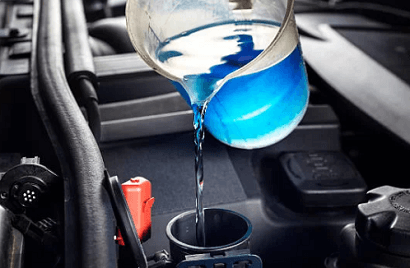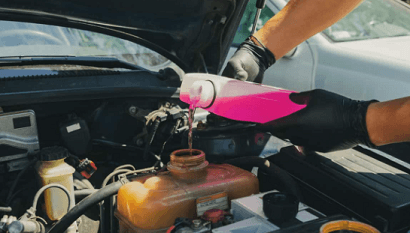Let your car cool for at least 30 minutes before adding coolant to prevent injuries and damage. Adding coolant to a hot engine can cause it to overflow and result in burns or injuries.
It is essential to wait for the engine to cool down before adding coolant to ensure safety and prevent any potential damage. By allowing the engine to cool adequately, you minimize the risk of coolant overflow and protect yourself from any harm.
Therefore, it is crucial to exercise caution and wait for a minimum of 30 minutes before adding coolant to a car that has been running.
Importance Of Allowing Car To Cool Down
The importance of allowing your car to cool down before adding coolant cannot be stressed enough. By allowing your engine to cool down, you are preventing potential damage and preserving the efficiency of your coolant.
When your engine is running, it generates a significant amount of heat. Adding coolant to a hot engine can cause a sudden decrease in temperature, resulting in thermal shock and potential cracking of the engine block or cylinder head.
By giving your car time to cool down, you ensure a gradual decrease in temperature, minimizing the risk of thermal shock. This allows the coolant to effectively do its job by absorbing and dissipating heat, keeping your engine at a safe operating temperature.
It is recommended to wait at least 30 minutes after turning off your engine before adding coolant. During this time, avoid opening the radiator cap or the coolant reservoir cap as they may still be under pressure. Once your engine has cooled down, check your coolant level and add the necessary amount if needed.
Remember, taking a few extra minutes to let your car cool down can save you from costly engine repairs and ensure the longevity of your vehicle’s cooling system.
Factors Affecting Cooling Time
Factors Affecting Cooling Time:
The time it takes for a car to cool before adding coolant can vary depending on several factors.
Operating Temperature:
The operating temperature of the car engine plays a significant role in determining the cooling time. If the engine is hot, it is advisable to wait until it cools down to avoid any potential damage to the cooling system.
Ambient Temperature:
The ambient temperature, or the temperature of the surrounding environment, can also affect the cooling time. In hot weather conditions, it may take longer for the engine to cool down compared to cooler temperatures.

Vehicle Type:
The type of vehicle can also impact the cooling time. Larger vehicles or those with higher horsepower engines may take longer to cool down compared to smaller vehicles.
Recommended Cooling Time
Maintaining the proper cooling temperature is crucial for the overall performance and longevity of your vehicle. When it comes to adding coolant to your car’s engine, it is essential to allow enough time for the engine to cool down. The recommended cooling time may vary depending on several factors.
| General Guideline for Most Vehicles |
|---|
| For most vehicles, a general guideline is to let your car cool for at least 30 minutes before adding coolant. This allows the engine to reach a safe temperature and reduce the risk of potential burns or damage. |
However, it is important to note that the cooling time may differ for extreme conditions. For example, if you have been driving in extremely hot weather or for extended periods, it is advisable to let your car cool for up to an hour or more. This additional cooling time helps the engine to dissipate heat adequately and allows for a more effective coolant refill.
Remember to always refer to your car’s owner’s manual for specific cooling time recommendations, as different vehicle models and manufacturers may have varying requirements. Properly cooling your car before adding coolant ensures the best performance and helps to prevent any potential damage to your engine.
Steps To Allow Car To Cool Down Properly
To properly cool down your car before adding coolant, follow these steps:
1. Turn Off the Engine: After parking your car, make sure to turn off the engine. Leaving the engine running will only generate more heat and delay the cooling process.
2. Open the Hood: Once the engine is off, pop the release latch inside your car to open the hood. This will allow hot air to escape and promote faster cooling.
3. Avoid Removing the Radiator Cap Immediately: It is crucial to let the engine cool down sufficiently before attempting to remove the radiator cap. Removing it immediately can result in hot coolant spraying out, causing injuries. Wait for the engine to cool completely.
By following these steps, you ensure the safety of yourself and your vehicle while allowing it to cool down properly before adding coolant.
Signs Of A Properly Cooled Engine
Properly cooling your car engine is crucial for its performance and longevity. Letting your car cool down before adding coolant is essential to avoid any potential damage. Signs of a properly cooled engine include a normal temperature level and the subsiding of steam.
| Normal Temperature Level | Steam Subsides |
|---|---|
| A properly cooled engine should operate at a normal temperature level, which typically ranges between 195 and 220 degrees Fahrenheit. | After turning off the engine, you may notice steam coming from the hood. This is normal and a sign that the engine is cooling down. As the engine cools, the steam should subside. |
It is important to give your car enough time to cool down before adding coolant, as adding coolant to a hot engine can cause damage. Always check the temperature gauge and wait for it to drop to a safe level before adding coolant. Additionally, remember to follow the manufacturer’s guidelines on the type and amount of coolant to use.
Dangers Of Adding Coolant To A Hot Engine
Adding coolant to a hot engine can be dangerous and lead to a range of health risks. First and foremost, the high temperature of the engine can cause the coolant to boil rapidly upon contact, resulting in steam and hot liquid splattering.
This can cause burns or scalds if it comes into contact with the skin. In addition, the hot coolant can emit toxic fumes when it evaporates, which can be harmful if inhaled. It is essential to let the engine cool down completely before attempting to add coolant to minimize the risk of accidents and health issues.
Besides the health risks, adding coolant to a hot engine can also cause potential damage to the engine. Rapidly cooling down the hot engine with cold coolant can create thermal shock, leading to cracks in the engine block or other components.
The drastic temperature change can also cause the coolant to lose its effectiveness in preventing corrosion and lubricating various parts of the engine. Therefore, it is crucial to wait for the engine to cool down to a safe temperature before adding coolant to avoid potential engine damage.
Consequences Of Not Allowing Sufficient Cooling Time
Insufficient cooling time can have detrimental effects on your car’s coolant system, putting your engine at risk. One consequence of not allowing enough time for the car to cool before adding coolant is decreased coolant effectiveness.
When the engine is still hot, the coolant may not be able to properly absorb and dissipate the heat, leading to inefficient cooling. This can result in engine overheating, which can damage important components and potentially cause more serious issues.
In addition, not allowing sufficient cooling time can increase the risk of overheating. If the coolant is added while the engine is still hot, it may not be able to cool the engine effectively, leading to higher operating temperatures. This can lead to further overheating, which can cause severe engine damage and potentially even engine failure.
Therefore, it is crucial to ensure that you give your car enough time to cool down before adding coolant. This will help maintain the effectiveness of the coolant and prevent the risk of overheating, keeping your engine running smoothly and avoiding costly repairs.
Common Coolant Types And Their Cooling Abilities
Common coolant types play a crucial role in determining the cooling abilities of a car. Ethylene Glycol-based coolants are one such type that is commonly used. These coolants are known for their excellent heat transfer properties and are capable of preventing the engine from overheating.
They are also effective in preventing freezing during cold weather conditions. Another type of coolant is propylene glycol-based coolants. These coolants are less toxic compared to ethylene glycol-based ones, making them a safer option.
While they may not have the same exceptional heat transfer properties as ethylene glycol-based coolants, they still provide adequate cooling for most vehicles. It is important to note that before adding any coolant, it is crucial to let the car cool down for a significant amount of time to avoid any potential damage to the engine.
Regular Coolant Maintenance For Optimal Engine Performance
| Regular Coolant Maintenance for Optimal Engine Performance |
| Subheading: Cooling System Flushing |
Proper coolant maintenance is crucial for ensuring optimal engine performance. One important aspect of coolant maintenance is cooling system flushing. Flushing the cooling system helps to remove any dirt, debris, or contaminants that may have accumulated over time, which can affect the performance and longevity of the engine.
It is recommended to flush the cooling system every 30,000 to 50,000 miles, or as per the manufacturer’s guidelines. Regular flushing helps maintain the cooling system’s efficiency and prevents overheating.
It is important to monitor the coolant level regularly. The coolant reservoir should be checked when the engine is cool to ensure that it is at the proper level. Low coolant levels can lead to engine overheating and potential damage. By following these maintenance practices, you can keep your engine running smoothly and avoid costly repairs.
Frequently Asked Questions Of How Long To Let Car Cool Before Adding Coolant
How Long Should I Wait For My Car To Cool Down Before Adding Coolant?
It is recommended to wait for at least 30 minutes to let your car cool down before adding coolant. This allows the engine to cool off and prevents any potential burns from hot components. Waiting ensures that the coolant will be added to a safe and stable temperature.
Why Is It Important To Let The Car Cool Before Adding Coolant?
Letting your car cool down before adding coolant is crucial to prevent any accidents or damage. Adding coolant to a hot engine can cause rapid pressure changes, leading to leaks or even bursting hoses. It is essential to wait for the engine to cool to a safe temperature to avoid potential risks.
What Happens If I Add Coolant To A Hot Engine?
Adding coolant to a hot engine can result in sudden pressure changes, which may cause leaks or damage to the cooling system components. It is important to let the engine cool down before adding coolant to prevent any potential accidents or structural failures in the cooling system.
How Can I Tell If My Car’s Engine Is Cool Enough To Add Coolant?
To determine if your car’s engine is cool enough, you can touch the hood lightly. If the hood feels warm but not scalding hot, it is likely safe to add coolant. However, it is always recommended to follow the manufacturer’s guidelines and wait for at least 30 minutes to ensure the engine has cooled down sufficiently.
Conclusion
To ensure optimum engine performance, it is crucial to allow your car to cool down before adding coolant. This allows the system to reach a safe temperature, preventing any potential damage. Remember, overheating can result in severe engine problems. Therefore, it is always best to be patient and allow your vehicle to cool adequately before adding coolant.
By following this simple step, you can prolong the life of your engine and avoid costly repairs in the long run.


Leave a Reply